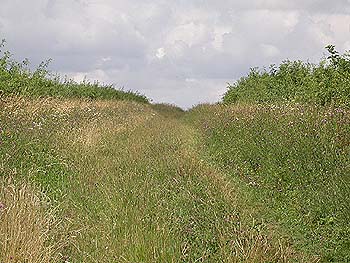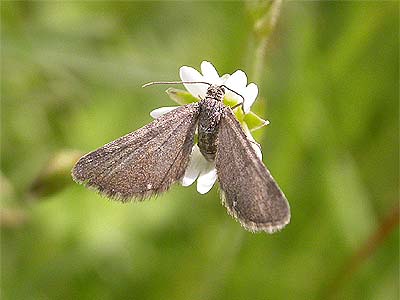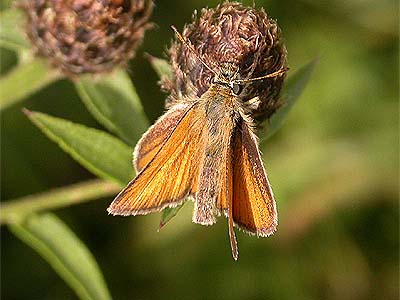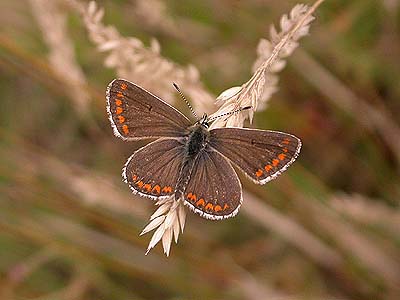

| Eakring SSSI under threat from planning application | |
| One of the area's few
remaining important habitats, was put under threat from a
planning application a few years ago. Mill Lane, situated on the south-west edge of Eakring village, is a designated SSSI (Site of Special Scientific Interest) and is one of the area's most important sites for it's varied range of flora and yet was wanted for use as a 4x4 track. Mill Lane is described by the Nottinghamshire Wildlife Trust as a "species-rich, green lane" The Essex Skipper butterfly was found in July 2003 and the Brown Argus was re-discovered for the first time since 2000 a short while after. Further brief searching of the site in the Summer of 2004, revealed that Mill Lane also held a small Marsh Pug population, whilst both the Essex Skipper and Brown Argus were still present. |
 |
|
| ......... | ||
| The
application was been made by an Eastwood resident, who
planned to create a circular route for the use of 4x4
vehicles, quad-bikes and trials bikes. Most of the
planned application was to make use of present farm
tracks, Mill Lane and some designated public roads within
Eakring village. Naturally there was a great deal of
concern from local farmers, landowners and village
residents. I was invited by the owners of Ryall's Farm at
Eakring, to attend a meeting at a packed village hall,
where many people voiced their disagreement with the
proposed plans. It seemed that stopping the proposed
application would be difficult, due to out of date laws
and legal technicalities. However, several years later, I
believe that no further plans have been submitted. Important species The following short species list features the rarest insects currently known to occur along Mill Lane. |
||
| Marsh
Pug Eupithecia
pygmaeata |
|||
| This is an inconspicuous
species, small and rather bland. Even by Pug standards,
it has few distinguishing markings - the most prominent
being the white spots on the forewings. The Marsh Pug was formerly ascribed a Grade 2 listing in the county and was immediately deemed to be one of the most important finds made during 2003. However, the Marsh Pug has recently been categorised as a Grade 1 Nottinghamshire species - following a change in its National Status from being Local to Nationally Notable. It's small size renders it quite inconspicuous and could be quite easily overlooked in other suitable habitats. The only other currently known site in Nottinghamshire are the Carr-lands around Misterton in the very north of the county. If this species continues to decline nationally, then a Red Data Book assignation is very likely and will offer much needed protection. |
 |
|
| ......... | ||
| In his book Moths of the British Isles, Skinner describes Marsh Pug as being very local and rather uncommon - occurring in widely scattered localities from Bedfordshire and Warwickshire, northwards to Cumbria and Yorkshire, North and South Wales, Isle of Man, Scotland including Orkney, and western and northern Ireland. | ||
| Essex Skipper Thymelicus lineola |
|||
| Like the Brown Argus, the
Essex Skipper's rise as a colonist, has come at more or
less the same time. Then again, many other butterflies
(which were once a very difficult find in
Nottinghamshire) have also continued to spread at a
terrific rate. The Essex Skipper is very similar to the closely related Small Skipper and the two are difficult to tell apart. Life-cycle differences mean that the Essex Skipper emerges a few weeks later than the Small Skipper (usually around the third week in July) then over-winters in the egg stage with the Small Skipper passing the Winter as a young larva. Larvae of both species feed on a variety of grasses Structural differences between the two are slight and quite subtle. However, once learnt seperating the two becomes quite easy to the trained eye. The most obvious difference is on the underside of the tips of the antennae - black on Essex Skipper and light-brown on Small Skipper. Since it's first appearance at Colwick Country Park in 1995, the Essex Skipper continued it's northward range expansion through south-eastern Nottinghamshire during the late 1990's. |
 |
|
| By 1998, several sites as far north as Cotham, had recorded their first examples, whilst Colwick and Holme Pierrepont, both continued to report the species on an almost annual basis. Because the Essex Skipper is extremely similar to the Small Skipper, it's further spread throughout the county, has probably passed unnoticed. It is extremely under-recorded, but now probably present over much of Nottinghamshire. | ||
| Brown
Argus Aricia
agestis |
|||
| The Brown Argus was
originally discovered in the Eakring and Kersall area
several years ago, soon following it's first occurrence
in the county for over 40 years. It has always been very
hard to find at Eakring and remains one of the area's
rarest species due to habitat restriction. Following several surveys of suitable sites in the area, the Brown Argus was finally re-discovered on August 8th 2003, along Mill Lane near Eakring village. Other sites where it had been observed previously (with the exception of the adjacent Oil Bore Holes) are either heavily grazed by sheep and cattle or cut for hay in mid-July. The Brown Argus seems to require areas of short grass or pockets of sparsely vegetated open ground. Mill Lane provides such habitat through it's common use as a public footpath and farm track during the Winter months. |
 |